The scenic Spanish holiday that will make your children smarter
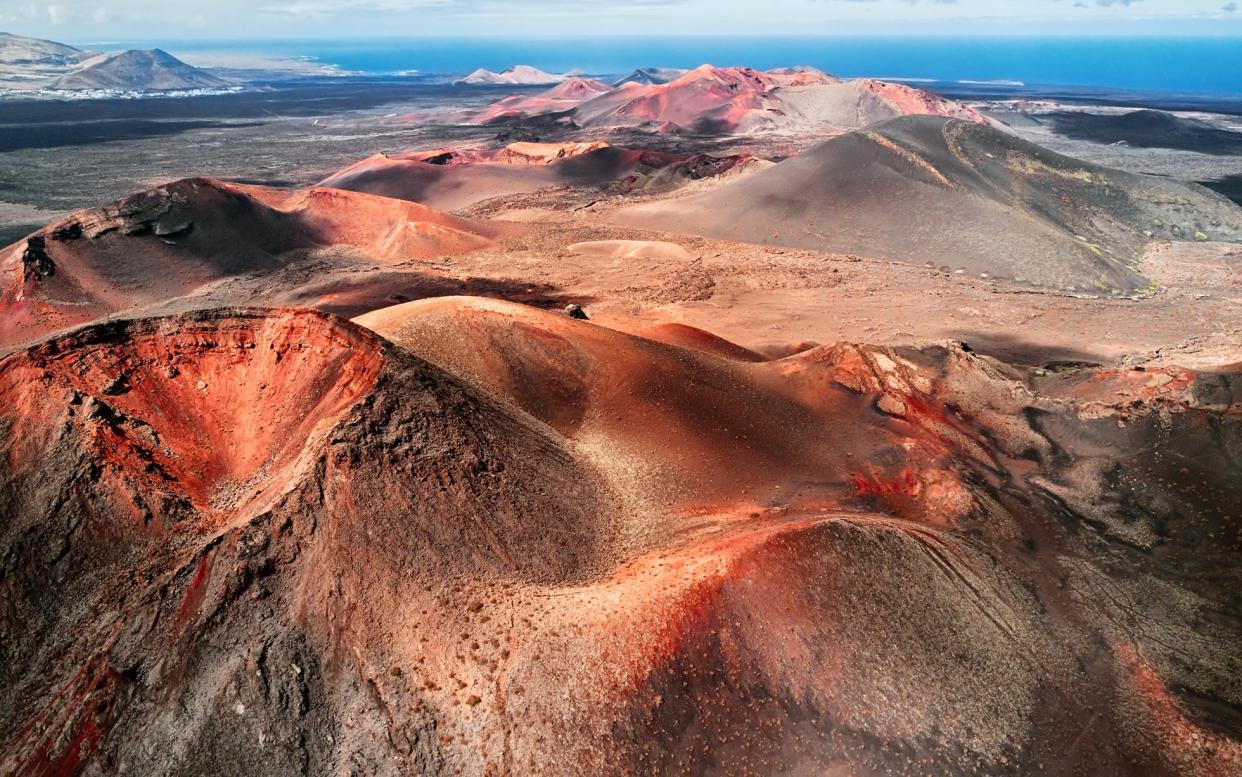
The view, as you fly into Lanzarote, is unusual. It’s not white sand and sunburnt hills: it looks black, almost dirty. Closer to land, the earth is shattered, roads winding between dark rocks. The rubble appears freshly churned.
If you didn’t know better, you could see it as ugly; slag-heaps or building sites. But in fact it’s the remnants of a huge, devastating volcanic eruption that scoured the island between 1730 and 1736. It is a spectacular reminder of the power of the Earth.
The idea was to see if my kids – or, really, the elder one, Billy, who’s four; Ada, at two, is a bit young – would appreciate seeing that power close up, and learn something from it. It would be a sort of bucket-and-spade holiday with added educational value. Billy had recently been learning about volcanoes at preschool, and found them fascinating. But the classic volcanic geology holiday to Iceland seemed a bit much; they’re only little, and I still wanted to throw them in a paddling pool from time to time while I had a beer on a sun lounger.
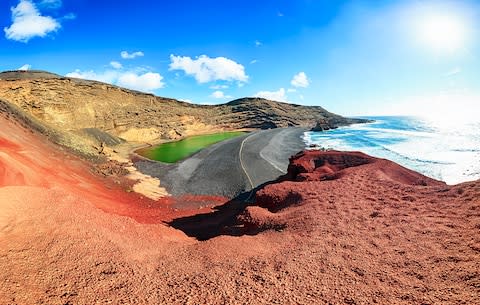
It was a spectacular success. Lanzarote was the best holiday the little Chivers family has ever been on.
The success lay, in part, because Billy is getting more biddable as he gets older. Until now, holidays with children were fun but not exactly relaxing; now, things that we simply couldn’t have done a year ago – such as family dinners out – were stress-free, enjoyable. Also easing the holiday was the fact that the resort we stayed in, the Princesa Yaiza in Playa Blanca, on the island’s south-western tip, was so well set up for young families.
But credit for the triumph sits also with this island: there is so much to do in Lanzarote. We turned down the organised tours – they sounded interesting, but at eight hours long, too much for toddlers. Instead, we rented a car and on our first day drove 10 miles (16km) up the coast to El Golfo, a black-sand beach.
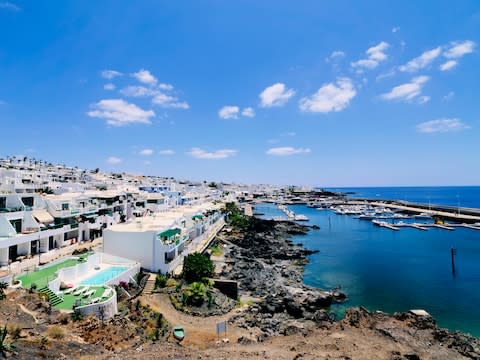
As we drove, Billy was full of questions. “Are volcanoes in real life?” he asked, nervously. “Will they burn us?” I explained that these are old volcanoes, dormant, which means asleep. They’re still hot, but the heat is deep beneath us. The red stuff, the lava or magma you see coming out of the top in films, that’s underground. You won’t see that. Billy nodded, apparently satisfied.
El Golfo is a little village based around a strange green lagoon, separated from the stark blue-and-white of the Atlantic Ocean by a strip of dark volcanic sand, although the two are linked by underground channels. We’d been a bit nervous about it, because we’d read it was a little underwhelming and that the “green lagoon” was insufficiently green. But it was wonderful.
Formed in the half-sunken crater of an extinct volcano, the lagoon is indeed green – the product of volcanic minerals and unique bacteria that live on them. It’s not lurid, but it’s certainly noticeable. And the climb up to the viewing point is exactly the level of difficulty you want when you’re wearing flip-flops and guiding two toddlers.
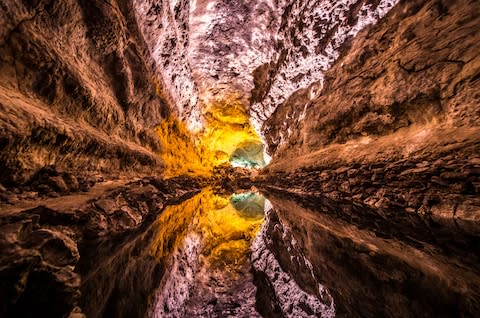
It’s also extremely informative. The story of Lanzarote’s birth is visible in the stone. As you go up to the viewing point, you walk beside rocks that clearly show the striation of sedimentary layers – they used, once, long ago, to be flat parts of the seabed. But they are now 100ft in the air and at a 45-degree angle. It’s a trace of how the volcanoes that form the island forced themselves out of the sea about 15 million years ago.
Billy looked at me dubiously when I explained this, and asked if Lanzarote used to be underwater – as though I were suggesting that it rose like a reverse Atlantis, water streaming from newly emerged souvenir shops and tapas restaurants. But we eventually established that the ground was under water, and then people came and built the roads and hotels and things.
Once we’d had enough of viewing the lagoon we wandered down to the rocky shore, where Billy and Ada played among the rock pools; the shore was covered with volcanic pumice, which, I explained, was full of bubbles from when it was molten, and the pools were full of little blennies and shrimp and a strange black swimming crab.
There was a little playground to entertain them – the kids, not the crabs – and lots of lovely fish restaurants. The one we chose for lunch, Mar Azul (no website for such small places), did an extraordinary fish of the day, and it backed onto the shore so we could carry on playing among the rock pools while we waited for our food.
The next day we set off for Timanfaya, a national park centred around the volcanoes that were most active in the 1730 event. You park and board a coach which takes you around this weird landscape (it’s not a coincidence that Lanzarote has been used as the location for several sci-fi and fantasy films, including One Million Years BC). It’s often described as “lunar”, but it’s not. It’s Martian. Looking out from the window of the bus, the images are amazingly reminiscent of the images sent back by the Mars Curiosity rover: broken land and rusted, iron-red earth.
The drive is bizarre. The Timanfaya eruptions covered a quarter of Lanzarote in lava, burying 11 villages and forcing the entire population to flee. To this day the heat of the ground and the sulphurous chemicals render it almost devoid of life; there are small bushes and lichens, but even three centuries later there are no grasses or forests.
The coach takes terrifying hairpin bends through the broken hills, stopping periodically for its three-language audio tour to tell you about some notable hill or local legend. Rain (we were spectacularly unlucky with the weather all week; usually in October you can expect 77F/25C daily and three days of rain a month) made it sometimes hard to see out of the windows, but when we could, we were surrounded by the open pits of old volcanoes. It was atmospheric to the point of spooky. It’s a toddler-friendly 45 minutes, and Billy and Ada both enjoyed it.
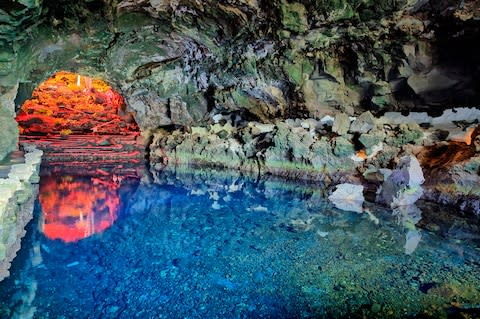
Back at the car park, a guide poured water into a hole where the geothermal heat blasted it up as a geyser, slightly scaring both children; another held dry wood down in a pit where the heat of the volcano set it alight. It was a bit less spectacular than I expected – even the guides looked bored – although Billy seemed to realise he was meant to be impressed, and made impressed faces. What was more impressive was the chicken cooking on spits over a volcanic pit, and the heat you could feel when you put your hands on the ground.
Another day we drove the whole length of Lanzarote to the Cueva de los Verdes, a cave created by eruptions about 3,000 years ago. It formed when hot lava flowed down the mountain; the top cooled and froze solid, and the still-molten lava inside flowed away, leaving a series of tunnels.
It was pretty spectacular, and the kids loved hurtling around inside the surprisingly spacious cave, although the obligatory guided tour was a bit ridiculous – we were a group of about 50, and the single guide spent most of her time telling us to hurry up and/or be quiet. It was very reasonably priced, but I’d have happily paid a bit more to go in smaller groups. If we had been staying nearer, it would have been a good morning out, but with an hour’s drive each way from Playa Blanca it felt more effort than it was worth. There is, it should be said, a rather good surprise at the end, but I can’t reveal any more.
We had planned after that to go to Jameos del Agua, a site at the mouth of the tunnel with reportedly spectacular sights and a volcanology centre, but by that stage our young ones were tired and hungry and it was a long drive home, so we bailed.
On the basis that all geology all the time might get dull, we tried to mix things up a bit with some marine biology. One day I took Billy on a submarine safari from the nearby Puerto Calero, which was pricey, but he was thrilled – for a four-year-old, seeing shipwrecks and several barracuda out of the porthole of a submarine is dramatic. We also wandered the marina at Playa Blanca, where the waters were full of grey mullet and sea bream; both children would kneel, transfixed, staring at them through glass set into the decking of a bar, while we adults enjoyed a drink.
Princesa Yaiza, our hotel, was absolutely perfect for our needs. The many pools were never intimidatingly full, and Billy was able to learn to snorkel in one of them. The food at the many restaurants was uniformly good, and the buffet-style set-up at some of them worked brilliantly with small children; our kids were shovelling it down.
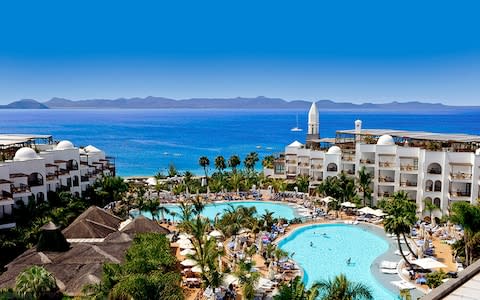
Since we were out and about most days, we didn’t make the most of the Kikoland children’s centre, but Billy and Ada loved the kiddie disco and stayed up well past their bedtime dancing with hyperactive young children’s entertainers. The staff were great with the kids and the room was spacious.
The hotel backed on to a beautiful white-sand beach, enclosed by an artificial reef, and the kids enjoyed making sandcastles and paddling, while I loved running along the promenade or snorkelling out to a rocky little island a couple of hundred yards offshore, seeing the surprising number of brightly coloured damselfish and parrotfish.
It’s not going to be mistaken for the Great Barrier Reef, but it was still beautiful, the water cold but pleasant and exquisitely clear (clear enough that I could see, swimming home, the room key that had fallen from my pocket on the way out, and was lying on the bottom of the sea 25ft beneath me – a little miracle I’ll always remember).
We left after a week, having carefully not overdone it – we left two days for just chilling around Princesa Yaiza. The kids were exhausted but happy (“I want to stay in Lanzarote forever,” declared Billy, who several days later was still talking about the submarine and the volcanoes) and we parents felt actually relaxed – a novel experience in the past four years. I dare say that we will be back.

